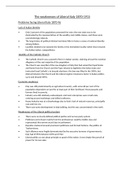The weaknesses of Liberal Italy 1870-1915
Problems facing Liberal Italy 1870-96
Lack of Italian identity
• Only 2 percent of the population possessed the vote; the new state was to be
dominated by the representatives of the wealthy and middle classes, and these were
overwhelmingly Liberals.
• The long history of political division had done little to foster a sense of national identity
among Italians.
• Loyalties tended to be towards the family or the immediate locality rather than towards
the Italian nation: campanilismo.
Hostility of the Catholic Church
• The Catholic Church was a powerful force in Italian society, claiming at least the nominal
allegiance of the vast majority of the population.
• The Church was resentful of the new kingdom of Italy that had seized the Papal States
and Rome from the Church and the Pope refused to legitimise the Italian state and
instructed loyal Catholic’s to boycott elections- this ban was lifted in the 1890s, but
distrust between the Church and the Liberal regime remained a factor in Italian politics
up to and beyond WW1.
Economic weakness
• Italy was still predominantly an agricultural country, with some 68 per cent of the
population dependent on land for at least part of their livelihood. Most peasants and
farmers lived in poverty.
• Industry was still relatively undeveloped, and most enterprises were small scale,
centring around workshops and skilled craftsmen.
• Heavy industry was at a disadvantage due to Italy’s lack of natural resources, principally
coal and iron ore.
• There was some development in ship building, but this was concentrated in the north.
Weaknesses of the Liberal political system
• There were no clearly defined political parties and no two-party system.
• Politicians were drawn mainly from the professional, wealthy middle class and
represented this narrow social class in parliament.
• Deputies clustered around prominent politicians and formed factions- the politics of
Trasformismo.
• Such alliances were fragile demonstrated by the excessive turnover of governments;
Italy had 29 PMs between 1870 and 1922.
• Liberal politics as not about principle or good of the nation; it was simply the pursuit of
power for its own sake.
, Growing challenges to Liberal political dominance 1896-1915
• There was economic growth in the first 20 years of Liberal Italy but, by the early 1890s,
the economy had fallen into depression.
• Companies and even banks had gone bust.
• The Banca Romana issued a large number of banknotes illegally, to the tune of 60 million
lire, on behalf of the Italian state and to leading politicians- this clearly smacked of
corruption and lowered the reputation of Liberal politicians even further.
• The economic depression of the early 1890s also led to protests and public disorder.
Sicily was placed under military rule and 40,000 government troops were despatched to
restore order.
• Crispi’s government survived the domestic crisis and he was determined Italy should
become a “Great Power”, equal for Britain and France.
• Crispi ordered Italian troops to occupy part of Ethiopia and war broke out in the Battle of
Adowa in March 1896. The Italian army was utterly defeated, leaving 5000 Italian
soldiers dead- a national humiliation.
• The events of 1893-6 severely damaged the prestige and self- confidence of Liberal
politicians and spurred economic depression, national humiliation and political
corruption, which would encourage the growth of opposition movements- these took
the form of socialism, Catholicism and nationalism.
Socialism
• Rapid industrialisation in northern Italy from the 1880s produced a sizeable working
class who were attracted to Socialist ideas concerning pay, working conditions and the
ownership of industry.
• A Liberal reform of 1881, allowing some 2 million more Italians to vote, provided an
added incentive for Socialists to organise.
• At the Genoa Congress of 1892, the movement divided into two broad groups:
moderates and radicals.
• The more moderate group, including Filippo Turati, became the PSI in 1895.
• By 1897, it had 27,000 members and ran its own newspaper, Avanti!
• In 1900, it received over 200,00 votes in the general election and secured 32 seats in the
chamber of deputies.
• Deputies were resolved to demand the introduction of universal male suffrage, an eight-
hour day, income tax and women’s rights.
• The emergence of socialism provoked great fears. Such fears were particularly
pronounced in the Catholic Church.
Catholicism
• By the 1890s, the Papacy began to focus its hostility on the rise of socialism, instead of
the Liberal regime.
• To the Church, socialism was a rival for the hearts and minds of ordinary Italians,
challenged social order and even rejected religion.
• The church removed its ban on Catholic’s voting in general elections.
• By 1909, Catholic’s were even permitted to put themselves forward as candidates for
election.





